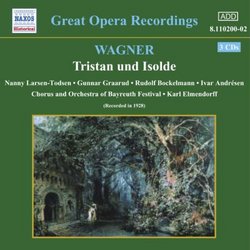An Even Finer Transfer
Ralph J. Steinberg | New York, NY United States | 07/24/2003
(5 out of 5 stars)
"I already reviewed this set in its Preiser incarnation. It is a superb performance and would be my ideal "Tristan," were it not for the severely abridged Act 3. Well, the Naxos transfer is even finer in sound, with clearer highs and even more solid bass than the Preiser. Naxos seems to be really leading the field in superb reissues of historical material. Good as the Preiser is, the Naxos is even better, and way cheaper, too. By the way, I'd like to see Naxos fashion a Gunnar Graarud recital disc; there is too little documentation of a really great Wagnerian tenor, in my not so humble opinion,far more musical than the rather elephantine Melchior. For that matter, a Nanny Larsen-Todsen disc wouldn't be a bad idea, either."
One-and-a-third Tristans from the 20s and Ernest Newman, too
J Scott Morrison | Middlebury VT, USA | 10/05/2003
(4 out of 5 stars)
"This 3CD set contains three curiosities--the first almost complete Tristan ever recorded and, almost contemporaneous with it, a 40-minute chunk of Act III recorded in England. And, further, there is an 8+ minute track with that redoubtable Wagnerian of the time, Ernest Newman, explaining 'the motifs and their functions in the opera.'The primary attraction here is the recording from Bayreuth, conducted by Karl Elmendorff, with Nanny Larsen-Todsen, Isolde; Gunnar Graarud, Tristan; Anny Helm, Brangäne; Rodolf Bockelmann, Kurwenal; and Ivar Andrésen, King Marke. Recorded in August, 1928, the transfer is amazingly good for a recording made so early in the electric period. Credit for this (and the equally good transfer of the other material) goes to wizard engineer, Ward Marston. Both the protagonists are sung in a lyric fashion a bit unusual either for the time or for now; consequently they are best in the slow, lyrical music. The music gets louder and tempi quicken when passion mounts in Act II and their voices tend to get a little out of control. Still, 'O sink' hiernieder' and what follows is lovely and sensuously sung (and played gorgeously by Elmendorff and his orchestra). Ivar Andrésen is a splendid King Marke, with his black bass; he also sings in the English-made Act III included on CD 3. I was not as impressed with Helm as Brangäne. Rudolf Bockelmann's Kurwenal is, to my ears, merely acceptable.In the Bayreuth recording there is a huge cut in Act III, although we get the 'high points,' of course. Larsen-Todsen's Liebestod is lovely.The English Act III excerpt, recorded 1926-27, is a bit of a dog's breakfast in that it was not all recorded at the same time, in the same place, or with the same conductor, orchestra and singers. In fact, we have three different conductors (Albert Coates, Leo Blech and Lawrence Collingwood) and three different singers as Kurwenal. The Tristan is the reigning English tenor of the time, Walter Widdop; his voice has more heft and thrust that Graarup's, and he handles the excitement in Scene II better than his Norwegian contemporary. The Isolde, Göta Ljungberg, however, tends to have a, to me, irritating vibrato that detracts from her fine musicianship and passionate characterization. Since this English set was made in different places and over a period of two years, sound levels--not to speak of pitch levels--are wildly variable and their matching was undertaken brilliantly by Marston. I was thrilled to hear Ernest Newman explaining the leitmotifs in the opera; I had read and re-read his writings on music over the course of almost fifty years and, like most music-lovers who read a lot about music, have always held him in the highest esteem. Obviously, this set should not be anyone's only recording of Tristan. My favorite is the Furtwängler/Flagstad/Suthaus recording; there are others that are also fine. But if you are interested in historical recordings, this one is important and I'm glad I have it. A plus, of course, is that Naxos's price is remarkably low.Scott Morrison"

